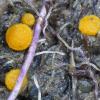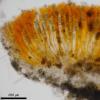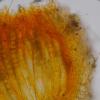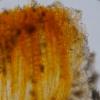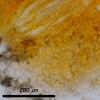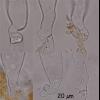
20-12-2025 15:47
Mirek GrycHi.These grew on pine wood that was heavily covere

18-12-2025 21:17
Pol DebaenstThe identification took me to Byssonectria deformi

15-12-2025 07:09
 Danny Newman
Danny Newman
indet. Rutstroemiaceae sp. on unk. fallen leavesMc

19-12-2025 10:10
Patrice TANCHAUDBonjour, récolte réalisée en milieu dunaire, a

18-12-2025 17:23
 Bruno CouĂ©
Bruno Coué
Bonjour,je serais heureux d'avoir votre avis sur c

18-12-2025 18:07
Margot en Geert VullingsThese plumes were found on rotten wood.They strong

17-12-2025 18:35
 Michel Hairaud
Michel Hairaud
Bonjour à tous/Hi to everyone I am passing along

21-11-2025 10:47
 François FrelĂ©choux
François Freléchoux
Bonjour,Peut-ĂȘtre Mollisia palustris ?TrouvĂ©e su

15-12-2025 15:48
 Danny Newman
Danny Newman
Melanospora cf. lagenaria on old, rotting, fallen
Ramsbottomia crec'hqueraultii 280815 287
Miguel Ăngel Ribes,
06-08-2016 20:49
 Hi friends
Hi friendsI have this Ramsbottomia with rounded spores and mixed characters between R. crec'hqueraultii and R. macracantha.
Spores (1000x, H2O, live, without ornamentation): (19,2) 20,3 - 23,4 (23,6) à (19) 20,2 - 22,7 (22,9) ”m; Q = 1 ; N = 37; Me = 21,8 à 21,4 ”m; Qe = 1.
Ornamentation length: (2,2) 2,6 - 3,9 (4,2) ”m; N = 45; Me = 3,3 ”m.
I think it is nearest R. crec'hqueraultii than macracantha because Me spores are 21,8 x 21,4 (only a little bigger than 20 ”m) and ornamentation is Me = 3,3 ”m, but all papers I have read have spore measures for crec'hqueraltii < 20 ”m and spiner never > 3,5 ”m. And in this collection some spines have a very broad base.
Perhaps my collection is a "joung" R. macracantha?
Thank you in advance.
Nicolas VAN VOOREN,
07-08-2016 09:53

Re : Ramsbottomia crec'hqueraultii 280815 287
Hi Miguel.
You lost your Cotton Blue  ;-)
It would be interesting to know more about the other characters, especially the "hairs", and the habitat.
You lost your Cotton Blue  ;-)
It would be interesting to know more about the other characters, especially the "hairs", and the habitat.
Miguel Ăngel Ribes,
07-08-2016 17:50

Re : Ramsbottomia crec'hqueraultii 280815 287
Jejeje, don't worry Nico, next time, despite this impressive ornamentation, I will use CB, CRB or another blue.
This Ramsbottomia was neighbor of Boudiera tracheia, at alpine place, in a very, very humid slope of a small stream, between mosses, with Juncus, Aconitum and another small herbs.
An this are the pictures.
This Ramsbottomia was neighbor of Boudiera tracheia, at alpine place, in a very, very humid slope of a small stream, between mosses, with Juncus, Aconitum and another small herbs.
An this are the pictures.
Nicolas VAN VOOREN,
09-08-2016 19:07

Re : Ramsbottomia crec'hqueraultii 280815 287
Hi.
In alpine zone, the most common species is R. asperior, but the spores of this collection seem to be too large (and not enough subglobose) to fit the latter.
R. lamprosporoidea is another hypothesis, but the "hairs" should be more coloured and longer (I think you remember our discussion about this taxon and some Pyrenean collections).
In all cases keep this collection, a DNA sequence could be useful to clarify the taxonomy of each taxon...
In alpine zone, the most common species is R. asperior, but the spores of this collection seem to be too large (and not enough subglobose) to fit the latter.
R. lamprosporoidea is another hypothesis, but the "hairs" should be more coloured and longer (I think you remember our discussion about this taxon and some Pyrenean collections).
In all cases keep this collection, a DNA sequence could be useful to clarify the taxonomy of each taxon...
Miguel Ăngel Ribes,
09-08-2016 19:40

Re : Ramsbottomia crec'hqueraultii 280815 287
Hi Nico
We have a collection of R. lamprosporoidea published in "ContribuciĂłn al conocimiento de la micobiotal de Parque Natual de la Sierra Norte de Guadalajara. CatĂĄlogo y especies mĂĄs interesantes I. Bol. Soc. Micol. Madrid 38: 163-181. 2014" (link here: https://www.dropbox.com/s/kilf85z3nt3683z/Contribucion%20conocimiento%20micobiota%20del%20PN%20Sierra%20Norte%20de%20Guadalajara%20-%20Campos%202014.pdf?dl=0):
* with subglobose spores, not rounded, (16,1-)16,9-18,9(-19,3) x (13,8-)14,8-17(-17,4) m” Q = (1-)1,05-1,18(-1,2); N = 41; Me = 17,9 x 16 ”m ; Qe = 1,1.
* with darker hairs of (72,3-)103,5-134,9(-162,3) x (11,7-)13,3-22(-24,3) ”m; N = 34; Me = 118 x 17,5 ”m
The length hairs is similar in both collection, but not the spore shape.
We could try to sequenced it.
Thank you.
We have a collection of R. lamprosporoidea published in "ContribuciĂłn al conocimiento de la micobiotal de Parque Natual de la Sierra Norte de Guadalajara. CatĂĄlogo y especies mĂĄs interesantes I. Bol. Soc. Micol. Madrid 38: 163-181. 2014" (link here: https://www.dropbox.com/s/kilf85z3nt3683z/Contribucion%20conocimiento%20micobiota%20del%20PN%20Sierra%20Norte%20de%20Guadalajara%20-%20Campos%202014.pdf?dl=0):
* with subglobose spores, not rounded, (16,1-)16,9-18,9(-19,3) x (13,8-)14,8-17(-17,4) m” Q = (1-)1,05-1,18(-1,2); N = 41; Me = 17,9 x 16 ”m ; Qe = 1,1.
* with darker hairs of (72,3-)103,5-134,9(-162,3) x (11,7-)13,3-22(-24,3) ”m; N = 34; Me = 118 x 17,5 ”m
The length hairs is similar in both collection, but not the spore shape.
We could try to sequenced it.
Thank you.


